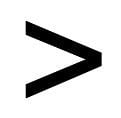 | ||
The greater-than symbol is used in various operations that usually pertain to work being done mathematically or with a programming language. The symbol looks similar to a sideways V and has been used in recorded literature as old as the 1560s. Generally, the symbol is used to show inequality between two numbers or expressions. In mathematics, if there are 2 numbers being looked at as an inequality, the greater-than symbol usually goes in between the two and symbolizes that the first number is greater than the second number (For example: 4 > 2, or 102 > 100). There are other combinations of the greater-than symbol and the 'equals' symbol or the greater-than symbol beside another greater-than symbol that are also used mathematically and computationally.
Contents
History
The symbols < and > first appear in Artis Analyticae Praxis ad Aequationes Algebraicas Resolvendas (‘The Analytical Arts Applied to Solving Algebraic Equations’) by Thomas Harriot (1560–1621), which was published posthumously in 1631. The text states: "Signum majoritatis ut a > b significet a majorem quam b" and "Signum minoritatis ut a < b significet a minorem quam b."
According to Johnson (page 144), while Harriot was surveying North America, he saw a Native American with a symbol that resembled the greater than symbol both backwards and forwards ( > and < ). Johnson says it is likely he developed the two symbols from this symbol.
Computing
The greater-than sign (>) is an original ASCII character (hex 3E, decimal 62).
The character in Unicode is U+003E > gt (HTML > · >); this is inherited from the same value in ASCII.
Apart from this, Unicode also has the following variants:
〉 · ⟩)Angle brackets
The greater-than sign is used for an approximation of the closing angle bracket (⟩). ASCII does not have angular brackets.
Programming language
BASIC and C-family languages, (including Java and C++) use the operator > to mean "greater than". In Lisp-family languages, > is a function used to mean "greater than". In Coldfusion and Fortran, operator .GT. means "greater than".
Double greater-than sign
The double greater-than sign (>>) is used for an approximation of the much greater than sign (≫). ASCII does not have the much greater-than sign.
The double greater-than sign (>>) is also used for an approximation of the closing guillemet (»).
In Java, C, and C++, the operator >> is the right-shift operator. In C++ it is also used to get input from a stream, similar to the C functions getchar and fgets.
In Haskell, the >> function is a monadic operator. It is used for sequentially composing two actions, discarding any value produced by the first. In that regard, it is like the statement sequencing operator in imperative languages, such as the semicolon in C.
Triple greater-than sign
The triple greater-than sign (>>>) is the unsigned right shift operator in JavaScript, and is the default Python prompt of the interactive shell, often seen for code examples which can be executed interactively in the interpreter- project-dir
Greater-than sign with equals sign
The greater-than sign plus the equals sign (>=) is used for an approximation of the greater than or equal to sign (≥). ASCII doesn't have a greater-than-or-equal-to sign.
In BASIC, Lisp-family languages, and C-family languages (including Java and C++), operator >= means "greater than or equal to". In Sinclair BASIC it is encoded as a single-byte code point token.
In Fortran, operator .GE. means "greater than or equal to".
In Bourne shell and Windows PowerShell, the operator -ge means "greater than or equal to".
Hyphen-minus with greater-than sign
In some programming languages (for example F#), the greater-than sign is used in conjunction with a hyphen-minus to create an arrow (->). Arrows like these could also be used in text where other arrow symbols are unavailable.
Shell scripts
In Bourne shell (and many other shells), greater-than sign is used to redirect output to a file. Greater-than plus ampersand (>&) is used to redirect to a file descriptor.
Spaceship operator
Greater-than sign is used in the spaceship operator.
HTML
In HTML (and SGML and XML), the greater-than sign is used at the end of tags. The greater-than sign may be included with >, while ≥ produces the greater-than or equal to sign.
Electronic mail
The greater-than sign is used to denote quotations in the e-mail and newsgroup formats, and this has been taken into use also in forums.
Texting (SMS), online chat
The greater-than sign is used to express the act (or intent) of rubbing noses, typically in an affectionate or playful manner, with the recipient of the text/instant message.
